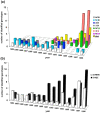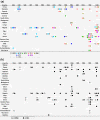Identification of pyrimethamine- and chloroquine-resistant Plasmodium falciparum in Africa between 1984 and 1998: genotyping of archive blood samples
- PMID: 22208458
- PMCID: PMC3309963
- DOI: 10.1186/1475-2875-10-388
Identification of pyrimethamine- and chloroquine-resistant Plasmodium falciparum in Africa between 1984 and 1998: genotyping of archive blood samples
Abstract
Background: Understanding the geographical distribution of drug resistance of Plasmodium falciparum is important for the effective treatment of malaria. Drug resistance has previously been inferred mainly from records of clinical resistance. However, clinical resistance is not always consistent with the parasite's genetic resistance. Thus, molecular identification of the parasite's drug resistance is required. In Africa, clinical resistance to pyrimethamine (Pyr) and chloroquine (CQ) was evident before 1980 but few studies investigating the genetic resistance to these drugs were conducted before the late 1990s. In this study, genotyping of genes involved in resistance to Pyr and CQ was performed using archive blood samples from Africa between 1984 and 1998.
Methods: Parasite DNA was extracted from P. falciparum-infected blood smears collected from travellers returning to Japan from Africa between 1984 and 1998. Genotypes of the dihydrofolate reductase gene (dhfr) and CQ-resistance transporter gene (pfcrt) were determined by polymerase chain reaction amplification and sequencing.
Results: Genotyping of dhfr and pfcrt was successful in 59 and 80 samples, respectively. One wild-type and seven mutant dhfr genotypes were identified. Three dhfr genotypes lacking the S108N mutation (NRSI, ICSI, IRSI; amino acids at positions 51, 59, 108, and 164 with mutations underlined) were highly prevalent before 1994 but reduced after 1995, accompanied by an increase in genotypes with the S108N mutation. The dhfr IRNI genotype was first identified in Nigeria in 1991 in the present samples, and its frequency gradually increased. However, two double mutants (ICNI and NRNI), the latter of which was exclusively found in West Africa, were more frequent than the IRNI genotype. Only two pfcrt genotypes were found, the wild-type and a Southeast Asian type (CVIET; amino acids at positions 72-76 with mutations underlined). The CVIET genotype was already present as early as 1984 in Tanzania and Nigeria, and appeared throughout Africa between 1984 and 1998.
Conclusions: This study is the first to report the molecular identification of Pyr- and CQ-resistant genotypes of P. falciparum in Africa before 1990. Genotyping of dhfr and pfcrt using archive samples has revealed new aspects of the evolutionary history of Pyr- and CQ-resistant parasites in Africa.
Figures


Similar articles
-
Large-scale survey for novel genotypes of Plasmodium falciparum chloroquine-resistance gene pfcrt.Malar J. 2012 Mar 28;11:92. doi: 10.1186/1475-2875-11-92. Malar J. 2012. PMID: 22453078 Free PMC article.
-
Molecular markers of anti-malarial drug resistance in Lahj Governorate, Yemen: baseline data and implications.Malar J. 2011 Aug 21;10:245. doi: 10.1186/1475-2875-10-245. Malar J. 2011. PMID: 21854642 Free PMC article.
-
Return of chloroquine sensitivity to Africa? Surveillance of African Plasmodium falciparum chloroquine resistance through malaria imported to China.Parasit Vectors. 2017 Jul 26;10(1):355. doi: 10.1186/s13071-017-2298-y. Parasit Vectors. 2017. PMID: 28747223 Free PMC article.
-
The mechanisms of resistance to antimalarial drugs in Plasmodium falciparum.Fundam Clin Pharmacol. 2003 Apr;17(2):147-53. doi: 10.1046/j.1472-8206.2003.00164.x. Fundam Clin Pharmacol. 2003. PMID: 12667224 Review.
-
Genetics of chloroquine-resistant malaria: a haplotypic view.Mem Inst Oswaldo Cruz. 2013 Dec;108(8):947-61. doi: 10.1590/0074-0276130274. Mem Inst Oswaldo Cruz. 2013. PMID: 24402147 Free PMC article. Review.
Cited by
-
A case of quadruple malaria infection imported from Mozambique to Japan.Am J Trop Med Hyg. 2014 Jun;90(6):1098-101. doi: 10.4269/ajtmh.13-0477. Epub 2014 Apr 14. Am J Trop Med Hyg. 2014. PMID: 24732464 Free PMC article.
References
-
- Campbell CC, Chin W, Collins WE, Teutsch SM, Moss DM. Chloroquine-resistant Plasmodium falciparum from East Africa: cultivation and drug sensitivity of the Tanzanian I/CDC strain from an American tourist. Lancet. 1979;2:1151–1154. - PubMed
Publication types
MeSH terms
Substances
LinkOut - more resources
Full Text Sources

